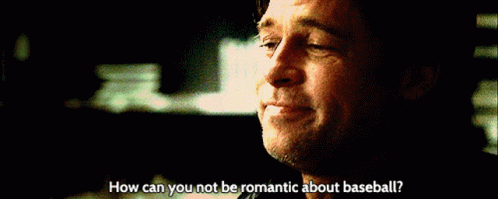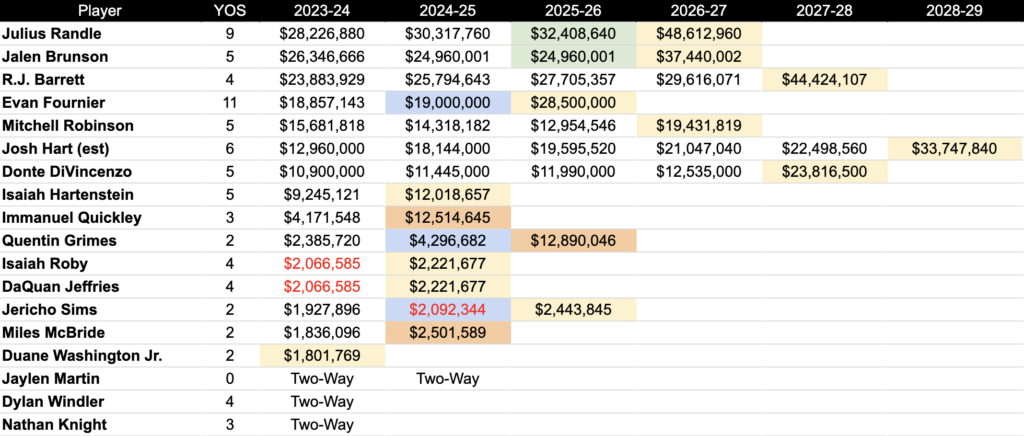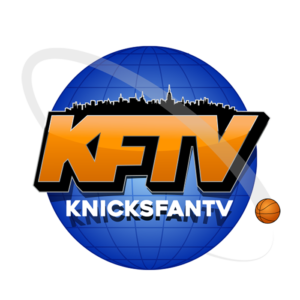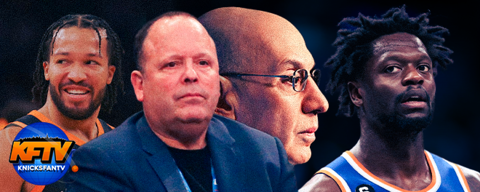The NBPA released the official details of the new CBA. How will it affect the Knicks moving forward?
Before we talk about the Knicks and the CBA, let’s quickly reminisce on some baseball history.
In 2002, Oakland Athletics general manager Billy Beane rebuilt the team after losing star free agents Jason Giambi and Johnny Damon to the more affluent New York Yankees and Boston Red Sox. By committing to sabermetrics, scouting for undervalued players, and trusting in the importance of on-base percentage, he fielded a team of underdogs that won 20 straight games and a league-best 103 wins with the third-cheapest payroll in the MLB.
Oakland’s 2002 season was so revolutionary in its cost-effectiveness that Michael Lewis wrote a book about it, Brad Pitt starred in the movie, and every organization has hired an advanced scouting team since. But ironically, their season ended in the division series that year, their MVP shortstop Miguel Tejada left in 2003, and 20 years later, they are preparing to be shipped to Vegas like the Raiders.

Why am I talking about Moneyball? Because on April 26th, the NBA and NBPA agreed to the terms of a new Collective Bargaining Agreement, and the full 676 document of details released on July 1st. I scoured every page (read: light skim with Command+F) for the hidden fine print that says the league must purposefully screw over the Knicks. I could not find it, but I know it’s in there somewhere.
The policy changes in the new CBA are pretty damning, though. Teams won’t have to construct rosters with a measly $41 million, but similar Moneyball tactics in player evaluation and penny-pinching should emerge more than ever before. A new addition to the regular season schedule and award qualification will also change the future of basketball history.
The Knicks’ offseason has been quiet, aside from adding Donte DiVincenzo and moving Obi Toppin. Is New York’s patience fit for the new changes coming to the league? And how prepared are they to become title contenders for the foreseeable future? Let’s assess:
2023-24 General cap info
- 2023-24 salary cap: $136 million
- Cap smoothing: The cap won’t increase more than 10 percent in any given year, regardless of additional league revenue.
- 2023-24 luxury tax line: $165 million
- 2023-24 nontax payers mid-level exception: $12.2 million
- Veterans can sign extensions that increase their salary by up to 40 percent in the first season of their new deal (up from 20 percent previously).
NBA max contracts are rising to ridiculous AAVs. It’s not too late to join a men’s league and work on your game, or sign your kid up for AAU.
Major financial penalties
- First apron: $6 million above the tax line. Any team that acquires a player through a sign-and-trade or uses either the non-taxpayer mid-level exception or bi-annual exception in free agency is not allowed to cross the line during the year.
- Second apron: $17.5 million above the tax line. Teams above the second apron cannot:
- use the taxpayer mid-level exception to sign free agents.
- sign players on the buyout market.
- send out cash in trades.
- aggregate player salaries together in a trade.
- take in more salary than they send out.
- trade first-round picks more than six years removed from the current year
- Teams are required to spend 90 percent of the salary cap by the start of the regular season. Teams that do not will not receive tax distribution.
The NBA and NBPA agreed to new repercussions for spending above the luxury tax. These changes could mean more front office frugality, more top-heavy rosters, more player movement via trade, and, hopefully, even more parity across the league. Free agency for fringe-level all-stars and below will become provide significant ultimatums as teams try to duck below the tax line.
Essentially, being above the second apron is saying: Our team is good enough, and we don’t need to make a move for more additional talent. How many teams have ever said that? For reference, Kevin Durant to the Suns, James Harden to the Nets, and DiVincenzo to the Warriors are moves that would be illegal today because of the new restrictions.
In the past, teams have prioritized retaining assets in free agency and would deal with the consequences later—those consequences look like the Jordan Poole and John Collins salary dump deals this summer. This talent redispersal shouldn’t end anytime soon, and that’s exactly what the league wants.
The Knicks’ payroll
The Knicks have 16 players signed for a total of $162 million, a tad below the tax line. Dumping Toppin’s salary was a heartbreaking move, but it shows decent foresight and adaptability from the front office. DiVincenzo will slide into his rotation spot and the Knicks will have some financial breathing room. Let’s take a look at their payroll, courtesy of No Trade Clause:

A Leon Rose masterclass. Even the furious Evan Fournier, whose deal expires in 2024, could be an asset to GMs looking to clear their books.
For the next two seasons, Julius Randle and Jalen Brunson will make a combined $52 million per year, just five million more than year one of Jaylen Brown’s supermax extension. Since both have player options in 2025, many are begging New York to take advantage of their cheap All-NBA production by doubling down on this two-year window to acquire a much-needed 1-A or 1-B star.
But even as their assets—future draft picks, Immanuel Quickley, and Quentin Grimes—slowly dwindle in value, the timing just doesn’t feel right to make a move yet. The reported Paul George price was too high, and the same may be true for Zach LaVine. Joel Embiid and Donovan Mitchell haven’t given the signal. Damian Lillard has a one-team trade list. The Thanasis Antetokounmpo ‘recruiter’ sweepstakes fell through. If Knicks fans want just any star, the best out there right now is James Harden.
Whiffing on this ‘window’ by sacrificing depth in a desperate move would make this era of Knicks contention shorter than #Knickstape. Patience is the best option for now, and as long as they remain below the apron, they’ll have access to the full MLE, meaning more quality role players like DiVincenzo. How many Dontes does it take to win a championship with this core? Hopefully, just one.
Budget production and draft picks
- All rookie-scale extensions can now last up to five years (previously four years maximum).
- Teams can now have three two-way players on the roster (previously, the number was two).
As supermax deals hover around 35% of the salary cap, getting production from players on budget deals and rookie-scale contracts will be key. Who’s the most underrated guy on the market? Who’s the draft sleeper? Can we trade for that guy on that team who deserves more playing time? Can that dude on the G-League squad make a shot and play defense? Diehard fanbases will regurgitate these questions weekly on podcasts and YouTube lives. (We are guilty).
The Nuggets struck gold with Bruce Brown on a $6.5 million prove-yourself deal season (he did, in fact, prove himself). The Heat landed great value in Caleb Martin (3 years, $20.4 million) with a J. Cole co-sign. Christian Braun (pick #21 in 2022), Gabe Vincent (undrafted), and Max Strus (undrafted) contributed for pennies in the finals. Time will tell if DiVincenzo (4 years, $50 million) plays well enough to be awarded the glorious ‘Most Underpaid’ award.
Summer League usually provides glimpses into the youthful contributors. Quentin Grimes executed the developmental goals he listed to CP during 2022’s Vegas finals run. This year was a bore in comparison. KFTV’s Geoffrey Campbell introduced us to Overtime Elite’s Jaylen Martin (no, not me!), and fans watched Isaiah Roby’s uneventful audition for the backup four spot. Despite a solid scouting department, New York has excused itself from keeping any draft picks of substance in the last two years (sorry, Trevor Keels). Why stop drafting now when it’s more valuable than ever?
The fate of financial flexibility will lie in finding budget contributors, regardless of whether the Knicks acquire a $50 million superstar or simply extend their current core. Trading every future first-round pick for a star would limit their options. Ideally, an NBA-ready rookie or two would replace Grimes and Quickley’s rookie deal slots as those players prepare to receive extensions in the next two years. Immanuel Quickley’s new deal may cause a frenzy in the near future…
The Suns miraculously signed nine players this offseason on a tight budget, promising playoff opportunity in exchange for a pay cut. The Knicks, now good, should have enough clout to attract veterans on minimum deals and MLEs, but the city’s income tax is high, and players will want guaranteed minutes; that’s not a guarantee with Thibs as coach. We’ll see how well Leon Rose can sell hopes and dreams to strengthen the depth.
In-Season Tournament
Our guys CP, Alex, and CK2K broke down the new in-season tourney live from the beautiful BlueWire studio in Vegas. CP broke down the Knicks’ schedule when it dropped. Here are the key points:
- The In-Season Tournament will begin Friday, November 3. The championship game will be played on Saturday, December 9.
- Teams have been divided into six groups of five teams each within their conference based on their 2022-23 regular season records.
- There are two stages: Group Play and Knockout Round.
- Group Play: In November, teams will play one game against each opponent in their group. Two games at home and two on the road.
- Knockout Round: In December, the best team from each group along with two ‘wild card’ teams will compete in single-elimination games for a prize pool of $500,000 per player, as well as the NBA Cup trophy.
The Knicks are in Group B with familiar foes: the Milwaukee Bucks (they were 0-3 vs the Bucks last season), Miami Heat (3-1 in regular season 2-4 in the playoffs), Washington Wizards (3-1 last season), and Charlotte Hornets (2-1 last season). The Knicks usually play to the level of competition, losing to the Bucks by an average margin of 7 points last season. However, they were 9-11 by November 28th last year before Thibs revamped the rotation. Continuity should help them find a rhythm early, but another slow start for RJ could have fans calling for his exile again. Let’s see how players, fans, and front offices react to the stakes of this new tournament.
The Larry O’Brien will always reign supreme, but the city of New York hasn’t seen a championship since 2011. It would feel good to win something, and an inaugural mid-season NBA cup would help put an official stamp on this new chapter of Knicks basketball.
Awards
- 65-game minimum for league award eligibility (MVP, DPoY, and All-NBA).
- All-NBA and All-Defensive teams will be positionless.
The NBA is firing shots at load managers around the league. New York’s strength in durability will likely be rewarded next season and beyond. For reference, Mitchell Robinson (59 games) was the only regular who wouldn’t have qualified for awards in 2022-23.
Was Jalen Brunson a top-15 player in last year’s regular season? The answer is maybe, and should 2023-24 be an encore, he could make himself eligible for a supermax extension in 2025.
Randle already hit his All-NBA incentive for his next deal. Immanuel Quickley has a legitimate shot at Sixth Man of the Year, as the oft-injured Malcolm Brogdon barely made the 65-game cut last season. Don’t count him, Grimes, or Robinson out for an all-defensive team, either.
Unfortunately, there is no official ‘Iron Man’ award for players to play all 82 games, but we’re still going to shout out Isaiah Hartenstein here, anyway.
Bonus: A few more interesting tidbits I found in the CBA document
- “The NBA shall identify for the Players Association any game(s) included in such draft schedule in which a Team is scheduled to play on the same day that such Team has traveled across two (2) time zones.”
Teams will have to travel across two time zones and then play a game that same night? Cruel.
- “…the Players Association may impose a fine of up to $125,000 on an agent for a violation of the rules regarding tampering, public requests or demands for a trade, or the timing of Contract negotiations.”
Whatever CAA, Kentucky, or Villanova mafia is going on in New York will have to move to Harlem alleyways or below ground in Grand Central station bathrooms. All eyes will be on the Knicks after the Dallas/Jalen Brunson fiasco.
- “For their participation in an All-Star Game, players on the winning team shall each receive $100,000 and players on the losing team shall each receive $25,000.”
Oh yes, I’m sure the league’s superstars will put on a competitive show for an extra $100,000. As if charity wasn’t enough of an incentive.
- “The NBA may determine during the term of this Agreement to expand the number of Teams…”
We all saw this coming. The league is too talented to have only 30 teams, so expansion would be best for the players, fans, and national basketball culture. The debates on which Knicks to protect in an expansion draft should be fun.
Conclusion: Parity is on the rise
This new CBA is causing everyone to ball on similar budgets. If the Knicks want to double down on their success, they’ll have to navigate these next few years with wisdom, foresight, and a little bit of luck.
The CBA is in effect until June 30, 2030. I’ll see you all then when we’re old and gray.
Stay tuned to KnicksFanTV.com for the latest Knicks news, rumors, and recaps throughout the NBA season. And in case you missed it, check out CP and The Athletic’s Mike Vorkunov breaking down the Knicks vs. Raptors lawsuit.















